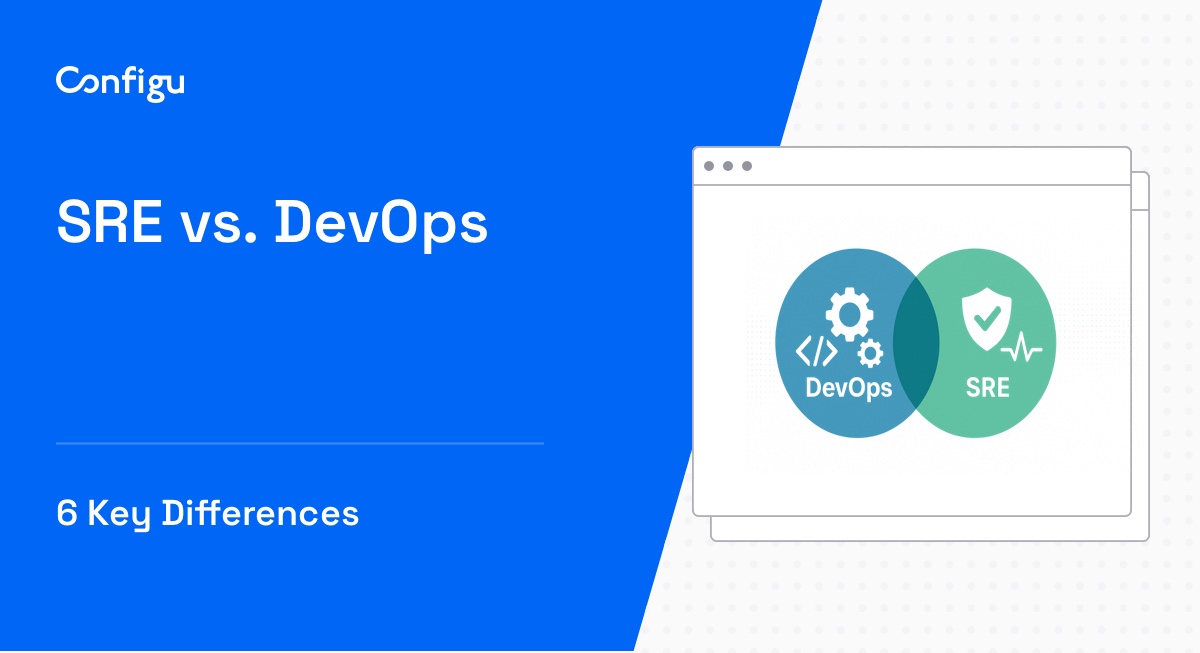Before co-founding Configu, Ran was a full stack developer at Testim.io and previously served in an elite cybersecurity unit in the Israeli Defense Forces.
What Are Configuration Files?
Configuration files are used to configure the parameters and initial settings of computer programs. They are used in a wide range of software, from operating systems to deployment systems like containers, to the applications that run on them. They provide a convenient way to customize and control how software applications operate.
In its most basic form, a configuration file is a simple text file that contains a list of settings, with each one on a new line. These settings can be anything from the color scheme of an application to the default directory for saving files. These files are often written in a human-readable language like YAML or JSON, but sometimes use more complex formats, like XML. They can typically be edited using a basic text editor.
Configuration files are vital because they allow users and developers to alter the behavior of an application without having to change the program’s source code. This is particularly useful in large, complex systems where changing the source code can be risky and time-consuming.
This is part of a series of articles about configuration management
In this article:
Anatomy of a Configuration File
Basic Structure and Components
At its core, a configuration file is a text file that follows a specific structure. This structure varies based on the language the file is written in, but there are some common elements:
- Header: A configuration file typically begins with a header that identifies the file type. This can be as simple as a comment that says # configuration file, or something more complex that includes the file’s version number and other metadata.
- Settings: Each setting is typically written on a new line and consists of a key and a value. The key is the name of the setting, and the value is what the setting should be.
- Footer: Some configuration files end with a footer. This can include comments, notes about the file’s history, or any other information that might be useful.
Tips From Expert
In my experience, here are tips that can help you better manage configuration files:
- Utilize hierarchical overrides: When using multiple environments, structure configuration files to allow overrides by higher-priority files (e.g., production overrides development).
- Leverage templating: Tools like Helm or Jinja2 templates help dynamically inject environment-specific settings into configuration files.
- Monitor configuration drift: Use monitoring tools that alert you when the configuration deviates from the expected state.
- Document configuration dependencies: Clearly map out configuration file dependencies to avoid hidden or cascading issues.
- Implement automated syntax validation: Automate syntax checks to catch human errors before deployment.
- Adopt atomic changes: Ensure configuration updates are atomic, meaning fully applied or fully rolled back, preventing partial deployments.
- Standardize file permissions: Apply strict permissions to ensure only authorized users can modify sensitive files.
Key-Value Pairs
Most configuration files are a collection of key-value pairs. This is the basic building block of the file, and each key-value pair is used to specify a particular setting.
A key-value pair consists of a key, which is the name of the setting, and a value, which is what the setting should be. The key and value are typically separated by an equals sign or a colon. For example, a key-value pair might look like this:
default_directory = /home/user/documents.Sections, Headers, and Hierarchy
In larger configuration files, it’s common to organize settings into sections. This is done using headers, which are lines in the file that start with a special character (like a bracket or a hash sign). Any settings that follow a header are considered to be part of that section.
This can be useful for organizing settings into logical groups. For example, you might have a section for network settings, a section for display settings, and so on. This makes the file easier to read and edit.
Comments and Annotations
Comments are a way of adding notes to a configuration file. They are lines that start with a special character (like a hash sign) and are ignored by the program reading the file. Comments can be used to explain what a particular setting does, to leave notes for other developers, or to temporarily disable a setting without removing it from the file.
Annotations are similar to comments, but they are used to add metadata to a setting. For example, you might add an annotation to a setting to indicate when it was last changed, who changed it, or why it was changed.
Related content: Read our guide to configuration management plan (coming soon)
Benefits of Using Configuration Files
Separation of Code and Configuration
One of the main benefits of using configuration files is that they allow for a clear separation between code and configuration. This means you can change the behavior of a program without having to modify its source code.
Ease of Deployment and Scaling
configuration files also make it easier to deploy and scale applications. By storing configuration data in separate files, you can quickly and easily change the behavior of an application as it moves from development, to testing, to production. This also makes it easier to scale an application across multiple servers or environments, as each instance of the application can have its own configuration file.
Portability and Platform Independence
Because they are simple text files, configuration files can be moved from one system to another very easily. This means you can use the same configuration file on a Windows machine, a Linux server, or a Mac laptop. This makes configuration files an ideal tool for cross-platform development.
Types and Examples of Configuration Files
Plain Text Files
Plain text files are the simplest form of configuration files and are easy to read and write. They are often used in Unix-like operating systems, where they configure the system and applications. For example, the /etc/passwd file in Unix-based systems is a plain text configuration file that stores user account information.
The simplicity of plain text configuration files makes them a popular choice for many developers. However, their lack of structure can also be a disadvantage, especially when dealing with complex configurations. In such cases, more structured formats like JSON or XML might be more suitable.
JSON files
JSON (JavaScript Object Notation) configuration files are a popular choice among web developers. They are easy to read, write, and parse, owing to their structured nature. JSON’s syntax is a subset of JavaScript, making it particularly suitable for JavaScript-based projects.
For instance, in a Node.js application, the package.json file is a JSON configuration file that holds metadata about the project, such as the project’s dependencies and scripts. JSON files are also commonly used in cloud services. For example, AWS uses JSON configuration files for many of its services, including AWS CloudFormation and AWS Lambda.
XML files
XML (eXtensible Markup Language) configuration files are another common type of configuration files. They offer a high level of flexibility, making them suitable for more complex configurations. XML files are widely used in Java-based applications, such as Apache Tomcat and Hibernate.
For instance, in Apache Tomcat, the server.xml file is an XML configuration file that configures the Tomcat server’s behavior, such as defining server ports and deployed applications. In Hibernate, the hibernate.cfg.xml file is an XML configuration file that configures database connection properties and mapping files.
INI files
INI (Initialization) files are a type of configuration file commonly used in Windows applications. They have a simple, section-based structure, making them easy to read and write. Each section in an INI file represents a separate data category, and each line in a section represents a key-value pair.
An example of an INI file is the php.ini file in PHP, which configures the PHP runtime environment. It includes settings for error handling, file uploads, and extensions, among other things.
ENV Files
ENV (environment) files are a special type of configuration file used to define environment variables. These variables can be used by applications to customize their behavior based on the environment they’re running in.
For example, an ENV file for a web application might define variables for the application’s database connection, API keys, and other sensitive settings. These variables can be read by the application at runtime, allowing it to adapt to different environments without the need for hard-coded settings.
ENV files offer several advantages. They are simple and easy to understand, making them suitable for developers of all skill levels. They also provide a secure way to handle sensitive settings, as they can be kept separate from the application’s codebase.
YAML files
Finally, YAML (YAML Ain’t Markup Language) configuration files are another increasingly popular type of configuration files. They are particularly popular in DevOps tools like Docker, Kubernetes, and Ansible, thanks to their readability and flexibility.
For example, in Docker, the docker-compose.yml file is a YAML configuration file that defines services, networks, and volumes for a Docker application. In Kubernetes, YAML files are used to define Kubernetes objects, such as pods, services, and deployments.
Related content: Read our guide to configuration-as-code
Best Practices for Managing configuration files
1. Keep Sensitive Data Secure
When working with configuration files, it’s crucial to keep sensitive data, like database credentials and API keys, secure. One way to achieve this is by using environment variables, which allow you to store sensitive data outside of your configuration files and codebase.
However, environment variables also present security risks, because they can be read by anyone with access to your operating environment. The most secure option is to encrypt and manage sensitive data using dedicated configuration management or secrets management tools.
Furthermore, it’s important to ensure that your configuration files are not publicly accessible, especially when working with web servers. For example, you should ensure that your server is configured to deny access to your configuration files from the web.
2. Maintain a Consistent Naming Convention
A clear and consistent naming convention can greatly improve the manageability of your configuration files. By adopting a standard naming convention, you can easily identify and locate your configuration files, leading to more efficient development and debugging processes.
For instance, you might decide to use a .cfg or .conf extension for all your configuration files, and you can have a common prefix for multiple configuration files related to the same system or process.
3. Use Version Control
Version control systems, like Git, are invaluable tools for managing configuration files. They allow you to track changes to your configuration files over time, making it easy to identify when and where a problem occurred.
Moreover, version control systems enable collaboration, allowing multiple developers to work on the same configuration files without overwriting each other’s changes. They also provide a safety net, allowing you to revert to a previous version of a configuration file if something goes wrong.
4. Regularly Backup Configuration Files
Regularly backing up your configuration files is another important best practice. This can save you a lot of headaches in case of data loss or corruption.
There are many ways to backup your configuration files. You can use a version control system, as mentioned above, or you can use a dedicated backup tool. You could also manually copy your configuration files to a secure location on a regular basis.
5. Use Configuration Management Systems
Configuration management systems can help you automate the lifecycle of configuration files. These tools allow you to define your desired system state in code, and then automatically apply that state to your systems.
Configuration management systems can greatly enhance your ability to manage and scale your applications. They ensure consistency across your systems, reduce manual errors, and save time by automating repetitive tasks.
Managing Configuration Files with Configu
One configuration management system you should consider is Configu, a configuration management platform comprised of two main components, the stand-alone Orchestrator, which is open source, and the Cloud, which is a SaaS solution:
Configu Orchestrator
As applications become more dynamic and distributed in microservices architectures, configurations are getting more fragmented. They are saved as raw text that is spread across multiple stores, databases, files, git repositories, and third-party tools (a typical company will have five to ten different stores).
The Configu Orchestrator, which is open-source software, is a powerful standalone tool designed to address this challenge by providing configuration orchestration along with Configuration-as-Code (CaC) approach.
Configu Cloud
Configu Cloud is the most innovative store purpose-built for configurations, including environment variables, secrets, and feature flags. It is built based on the Configu configuration-as-code (CaC) approach and can model configurations and wrap them with unique layers, providing collaboration capabilities, visibility into configuration workflows, and security and compliance standardization.
Unlike legacy tools, which treat configurations as unstructured data or key-value pairs, Configu is leading the way with a Configuration-as-Code approach. By modeling configurations, they are treated as first-class citizens in the developers’ code. This makes our solution more robust and reliable and also enables Configu to provide more capabilities, such as visualization, a testing framework, and security abilities.



